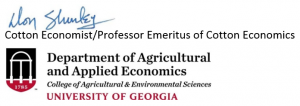 Don Shurley, Cotton Economist, UGA Emeritus Professor
Don Shurley, Cotton Economist, UGA Emeritus Professor
Last week’s USDA monthly crop production and supply and demand estimates contained some good news and some bad news. Overall, I’d have to consider the report somewhat bearish.
The market (new crop December futures prices) has been in a “downward-sideways” mode since mid-May and has been locked in a range of mostly 72 to 75 cents beginning in February. There has been solid support at 72 cents—but that support is being challenged in the wake of last week’s report, and heightened belief that the US crop could exceed current expectations.
 The good news in last week’s report included:
The good news in last week’s report included:
- Projected World use/demand for the 2016 crop year was raised a net 370,000 bales. China’s use was revised up ½ million bales.
- China’s imports for the 2016 crop year were raised 200,000 bales—from 4.8 to 5 million bales.
- Projected World use/demand for the 2017 crop year was raised 760,000 bales. If realized, this would be 2.6% growth from 2016 and 4.8% above the 2015 crop year. Demand/use is moving in the right direction.
- Expected production in China for 2017 was raised ½ million bales, but use was also raised ½ million bales. Stocks at the end of the 2017 crop year were lowered 300,000 bales, but that was due to increased use in 2016 and less carry-in.
The not-so-good news in last week’s report included:
- US exports for the 2016 crop year that ends July 31 were not raised as some expected it might be. Export sales already total 14.9 million bales, and actual shipments 12.5 million bales. The current estimate of 14.5 million bales will likely be raised in the July report.
- Projected US exports for the 2017 crop year were lowered ½ million bales from 14 to 13.5 million bales. This, in combination with a potentially larger crop, does not bode particularly well for prices.
- World trade for the 2017 crop year was lowered 790,000 bales from the May estimate. This was likely due to an increase in production of 1½ million bales from the May estimate.
- 2017 crop year imports into Pakistan, Mexico, and Thailand are now projected to be 810,000 bales less than the May estimate. All 3 countries are among the top 10 destinations for US exports for the 2016 crop year. Vietnam, Turkey, and Indonesia are also among the top 10 and are projected the same as for the 2016 crop year.
The first USDA survey-based estimate of actual acres planted will be out on June 31. Based on planting intentions, as reported back in March, abandonment adjusted for current moisture conditions, and 5-year average yields, the crop is currently estimated at 19.2 million bales. There seems to be a wide perception that the crop could be more than this.
As of June 11, the crop was 92% planted—slightly ahead of average. Planting is on normal pace now in most states including Texas. The crop is mostly ahead of average in growth and development, with exception of California and Alabama. As of June 11, the crop was rated 67% good to excellent compared to 53% last season at that time. The Texas crop is rated 62% good to excellent; Georgia is rated 70% good to excellent.
As mentioned previously, the 72-cent support area is being put to the test. Can it hold? If exports continue good and are adjusted up in next month’s report, that will offset some of what may be a larger crop estimate by that time also. If 72 cents doesn’t hold, the next support is around 70 cents, then 68.
The market has taken on a more cautious tone. It seems the market is waiting on something to knock it in one direction or the other. It’s still early, anything can happen, but there just seems to be more downside risk than upside potential at this juncture.
Growers who missed opportunities at 74 cents or better on December 17 contracts certainly don’t want to do something at 72 or less. The only strategies are to wait and hope, or go with Puts or minimum price contracts.
- Friday Feature:American Agriculture is Losing the Trade War in the Food Commodity Export Market - October 31, 2025
- Friday Feature:Ford Farms Featured on Local News Story about Peanuts - October 24, 2025
- September 2025 Weather Summary and Last Quarter Outlook - October 10, 2025


